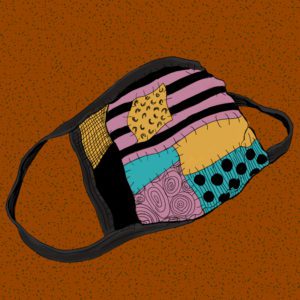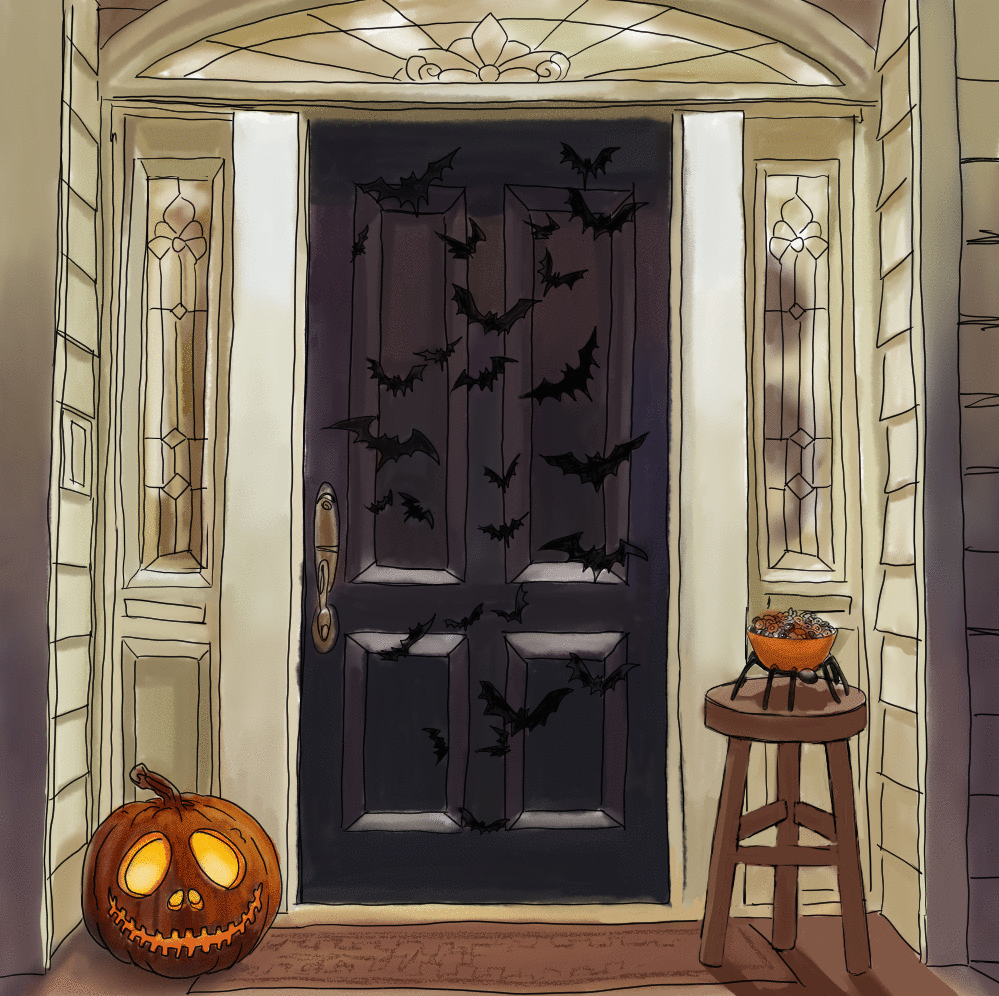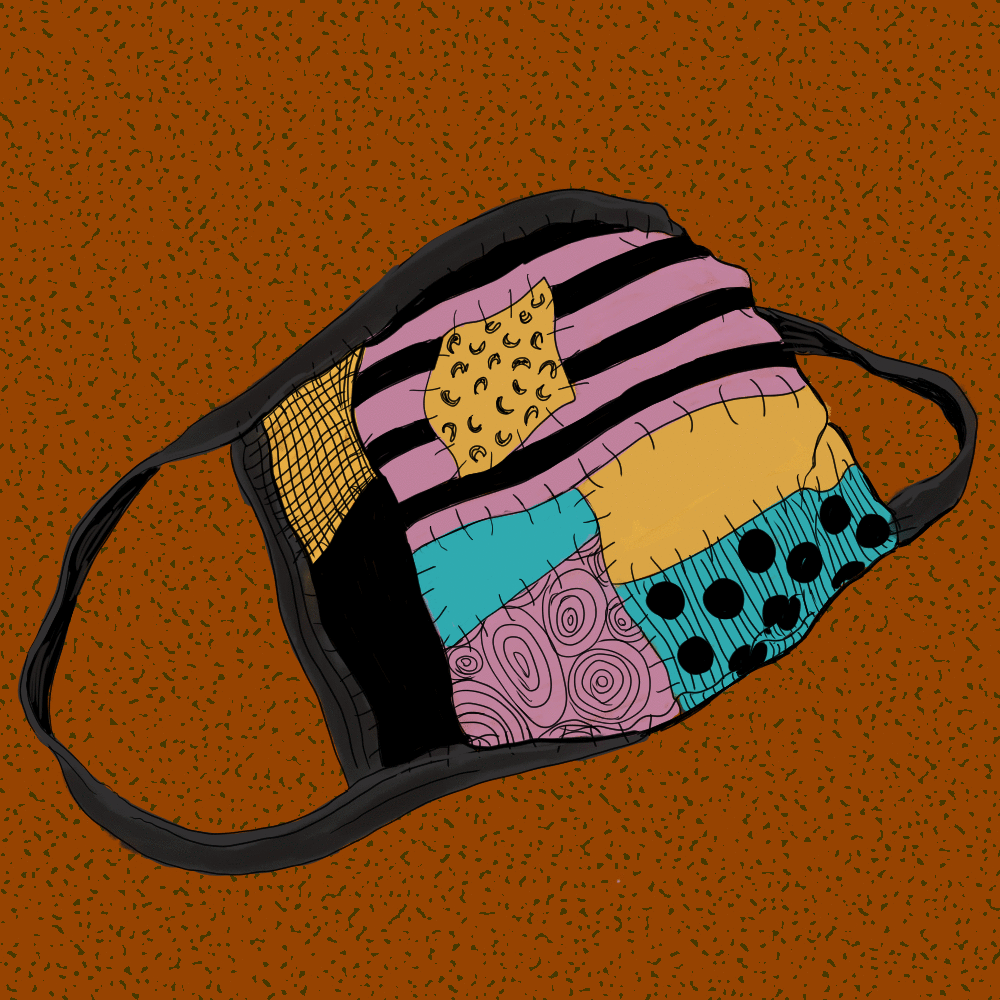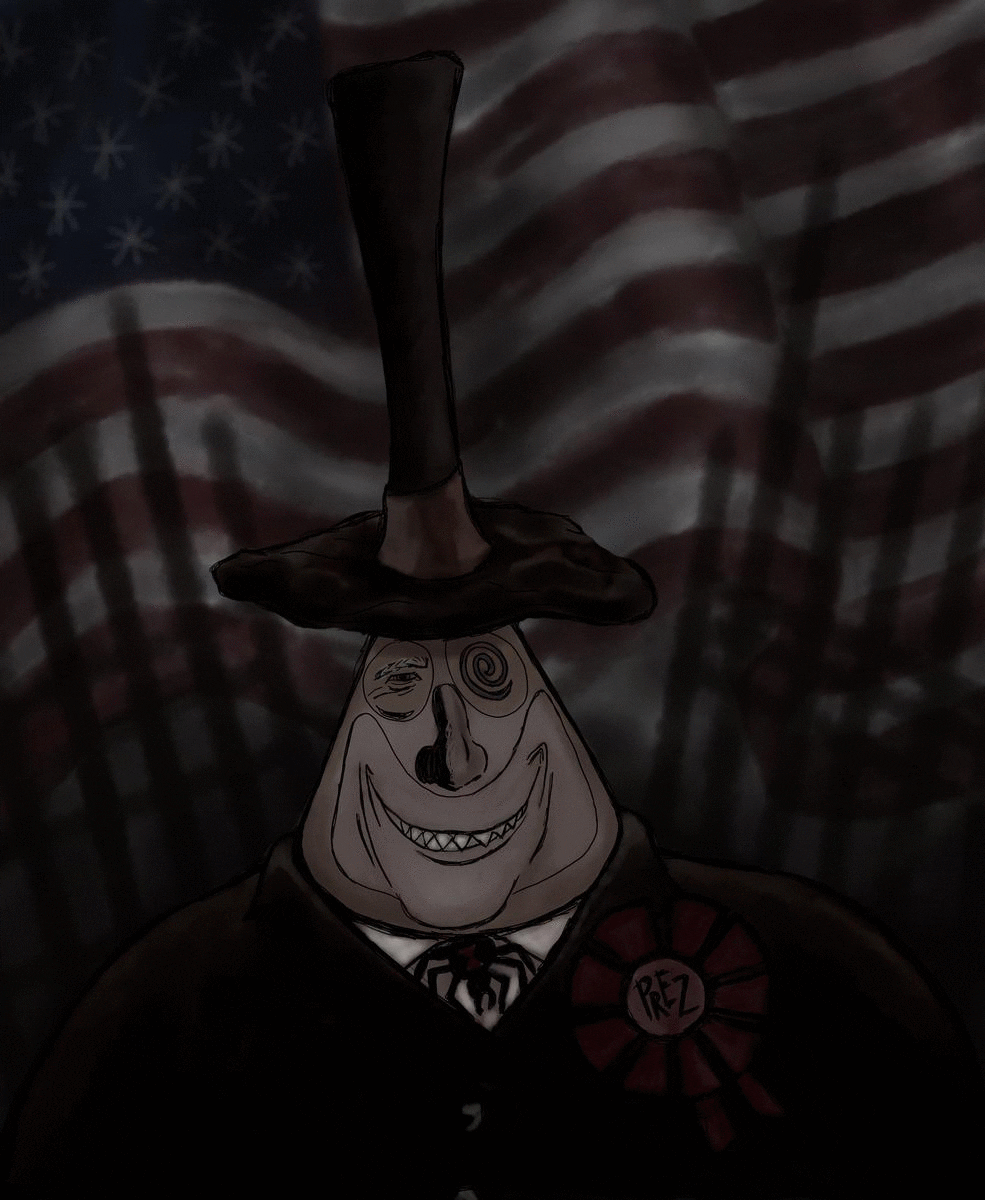
I sense there’s something in the wind.
I don’t consciously sing the lyrics. They rise from my throat like breath in frigid air, an undeniable sign that the seasons are changing. My gaze wanders to the window, where the edges of our street’s birch trees are toasting to crimson.
Every year before this one, when I caught myself singing “Sally’s Song” from The Nightmare Before Christmas, it was a little thrill—my favorite part of the year was on its way. I’d start sketching Halloween costume plans and switch my iced cold brew coffee to the piping-hot pumpkin spice latte. I’d pop into Target every day for a solid week to track when they boxed up the last remnants of back-to-school crayons and spiral notebooks and replaced them with this year’s crop of bone wreaths and black candelabras.
This year I’m sitting on the carpet with my eleven-month-old daughter, born last year as Labor Day weekend marked the finale of a mild Oregon summer. The seasons changed in those three days I spent in the hospital room, waiting hours for an induced labor to commence. We checked into the hospital on a balmy Thursday, and sometime in the night, gripping the side of the bed as another contraction woke me, a thunderstorm rolled into the Willamette Valley sky. The rain pummeled the tomatoes we’d left on the vine and beat the last fuchsias and dahlias into the gravel. In the afternoon, when she was born, it was cool enough for a light sweater. She arrived September 6, our wedding anniversary, creating an exponential new holiday to usher in the trove of joys at the end of each year.
Now, as the baby and I rearrange plastic cups and blocks on the floor, the song does not lilt off my lips. It sags in the air above me, not so much a hint as an omen. It is 2020, after all, and fall is coming.
In August I watched each day clip a few minutes shorter with an increasing sense of dread. During the summer months, the walls receded from their suffocation in pandemic spring. There is our patio, overrun with geraniums and herbs, expanding our small house out into the fresh air. There are the walks and bike rides I’d been taking in wide, wandering circles around our rural town, a place where all residents could empty into the streets and still be socially distanced. The berries flushed and the peaches softened, and though the world felt far from certain, it breathed. It overflowed with life, undisturbed by our human predicament.
The seasons may continue to change without hesitation, but my life, and the lives of everyone I know, have been stuck in an endless loop since March, when the specter of disaster flinted against all the tinder of our collapsing nation. We’ve all worn grooves through our small, tethered routines, learning the widths of our walls as well as the deepening lines in our faces. We wake up each day apart, dodging an invisible specter of death, watching with tied hands as our country folds into its own hubris like a dark star. We reside in a nightmare.
The Nightmare Before Christmas was released in October of 1993, but I was introduced to it the following year at the age of ten, when my mother brought home the VHS from Costco. My memory of watching Jack Skellington’s spindly legs step down the lavishly textured spiral mountain singing his lament is eternally vivid; leaning forward on the green plaid family couch with my little sister, the film’s whimsically macabre style left an impression so deep on my heart, I’m still digging into new layers over two decades later. I’m still finding new details in the frames.
One of the most appealing aspects of Tim Burton’s slow-simmered masterpiece was its novelty. Like the Pumpkin King waking up in a snow-blanketed North Pole after a lifetime of bogs and crypts, we’d never witnessed something that managed to be dark and delightful. We’d seen the canon of bright-eyed Disney animated classics, and puzzled over the shadowy ’80s rival studio entries like The Secret of Nimh, but this was the first thing we’d seen that landed perfectly between the two.
I remember the conversations with my sister in the car or our shared bedroom, debating which of the holiday lands we’d want to live in, if we could wander into a forest portal in Jack’s footsteps. The turkey door? The Easter egg? The Valentine? These imagined realms were discarded quickly, as the choice always came down to the two kingdoms depicted in the movie: Halloween Town and Christmas Town.
Yes, the best moments took place in the monochromatic Halloween Town, with its population of vampires, Swamp Things, witches, and boogeymen. No one special lived in Christmas Town—just a bunch of identical elves overseeing gingerbread cookies and rocking horse production, toddling through the snow back home to their brightly lit Whoville houses, sleeping soundly beneath layers of garland and peppermint. But, as enchanted as we both were by the spooky land glowing with character, we always circled back to the fact that no, we didn’t actually want to live in Halloween Town. We wanted to flirt with it, gaze into it, hear its melancholy song from the other side of the glass. It was the underground where stories grew, the firework-pain of hair playfully pulled before a kiss.
Christmas Town, much like the America I knew as a white, working-class child in the 1990s, was nestled in a quilt of exceptionalism. Calamities, darkness, nightmares—these were abstractions for a world outside of our magical borders. We would do just fine, like our parents’ generation had, and theirs before that, an echo carrying ever forward. In the glow of opportunity we feigned boredom, whipped our calm hearts into a froth of ennui that our lives were so unmarked by drama, intensity, peril.
But who here would ever understand
That the Pumpkin King with the skeleton grin
Would tire of his crown, if they only understood
He’d give it all up if he only could
All my life, watching this movie has marked the beginning of the fall. I put on the soundtrack as background noise while I drag a dozen ginormous Rubbermaid totes in from the garage, filled with the spooky decorations I’ve been collecting since my first college apartment, when I could barely afford a Chipotle burrito but still found enough dollars for fake pumpkins at JoAnn Fabrics. These are the traditions I’ve kindled from the brightest memories of my youth, the ones I dreamed of sharing and building even bigger with my own child.
But this year, the Rubbermaid totes waited in the garage as I weighed the ethics of retrofitting every flat surface of my house in grinning skeletons and mock tombstones when, at that point, almost two hundred thousand American neighbors and strangers had unceremoniously died from a virus that a sizable portion of my country won’t acknowledge exists. While a monster holding all of us hostage to his bottomless pit of ego, content with watching our suddenly fragile society implode as long as it means never having to admit he was wrong.
Jack Skellington doesn’t take over Christmas because of his competence. He does it on a whim after stumbling into something new, something novel, and deciding he’s entitled to a crack at it. Never mind that Santa and his elves have devoted their entire lives to the practice. They’re forcefully brushed away by Jack’s minions, rallied around their king’s cause after a catchy town hall song and dance. Only Sally the rag doll is dubious of the plan, eventually risking her own life to rescue Santa Claus and reset the Christmas holiday into the hands of experts.
And though I’d like to stand by him
Can’t shake this feeling that I have
The worst is just around the bend
There is no longer an escape into Nightmare. It is now a place we’ve lived for four eternal years. As much as I love this film, this tradition, the music and the lines I know well enough to recite in an impromptu one-woman show, I feel guilty for once finding respite here. There are no more forest doors to choose from. Only the leering Pumpkin King, dragging us down further down into a place that has already died.
Perhaps I am attempting my own holiday sleight of hand, a backwards magic up against all the dusky joy I’ve wrung from a season made vibrant by rot. If I don’t ring it in, mark it, revel in it, decorate for it, dress up in its name, sing its soundtrack, maybe I can stop it. Suspend the summer as a refuge from the indoor months, the impending debates, the looming night in November that will fork our lives. It is the same magical thinking that soothes the uncertainty with conspiracy.
Several weeks after my subconscious song ushered in the fall, I found myself in an unrecognizable parody of the season. The Oregon wildfires forced us to evacuate from our home, fleeing hours north to my parents’ house near Washington State’s Mount Rainier. In my childhood bedroom I folded the clothes I threw into a bag before bolting from a sky so red, Tim Burton would never have approved it for Jack’s kingdom. Much too unrealistic for a mythical monster village. I set up my laptop and let the movie stream from Disney+ for a child too young to know existential terror but old enough to fall under music’s spell. All of the markings of autumn were now canceled: her birthday, Oktoberfest, pumpkin patches, the state fair, trick-or-treating. Time continued, just without the joy of what had always been, replaced by the looming hex of all that could be worse.
This year, I didn’t smile when skeleton Jack rose from the gurgling green fountain. His scarecrow fire dance felt too bright and familiar. His languor now seemed unsympathetic, the same way I looked back on my own. The monochrome landscape no longer contrasted what we photographed, stupefied, as if an image could give a sense of the toxins and devastation damming our breath.
But then, Sally appeared. Sally in her straining-pastel patchwork dress, as if made from the tiniest slivers of beauty in her forsaken home. Sally lurking behind the tombstones, in the back of the audience, behind the swing of a gate, the single perch of wisdom mapping the chaos as it unfolds. She is animated with an unsteady gait, a hesitance, a shyness that betrays her relentlessness to change everything she cannot accept. Whether it is her own captivity or the misguided holiday takeover orchestrated by her community. She sees past them all into the love that could, so easily, be.
Maybe there is a reason that I begin every fall with “Sally’s Song.” Even this doomed, dark one. Especially this doomed, dark one. Not Jack, not Oogie Boogie, not that little trio of assholes. My heart keeps the lament of Sally, who saves Halloween Town from its own morass. Rescuer of Jack and his world when he is so, so far from deserving that grace. She may be overruled and overshadowed, but she is still there, pulling her body apart at its seams in order to give her sunken, ugly place a fighting chance.
A week after Halloween, I play my favorite spooky movie as I decorate every square inch of our house in Christmas decorations. I have stood unmoving in two camps: The Nightmare Before Christmas is a Halloween movie, not a Yuletide one; and the holly doesn’t come out until the turkey is in the trash. But I couldn’t bring myself to play the film on the night I’m normally bouncing up and down to the door, instead cowering in our darkened house like someone who thinks costumes are for overgrown children. Being trapped inside brought out the true “fuck it, let’s deck the halls” spirit in me. It felt only appropriate for the film to bridge these seasons, so unlike the ones I used to know.
The ending to the movie rises in an epic crescendo of the score, where the television news report of Santa’s return rouses the witches and monsters from their fitful, worried sleep. Jack rides through the gates of town like a matador, as his subjects cheer in the streets.
Jack’s okay, and he’s back, okay
He’s all right, okay
Let’s shout, make a fuss
Scream it out, whee!
As Jack absorbs the adoration, Sally remains back in the Mayor’s hearse, watching the spectacle with half a smile. She knows the capriciousness of the crowd, its zeal for coopting another holiday replaced overnight with the joy of returning to what they’ve always known. I, too, remained in the background on this most joyous Saturday, November 7. The morning when my husband yelled from the bathroom, “He’s got Pennsylvania! They called it!” I didn’t drive downtown to dance, didn’t bang my pots and pans. My party was opening a moderately priced bottle of sparkling wine in my driveway and refusing to think about the mess we’d all made for one solid day.
Unlike Jack and Sally, we have no Santa to play clean-up crew on our id-fueled disaster. Joe Biden did not appear in a sled over the town, replacing all the racist, hateful, misogynistic tendencies of our culture we’ve allowed to run free-range for the past four years with beautiful gifts. There is no Hollywood light switch, and I know this because I am old now and believe in repercussions. It would take lifetimes to stop-animate the repair we’ll undertake for decades after unleashing our Pumpkin King on an unsuspecting world.
I didn’t choose to live in this era, just as the swamp things and vampires had no choice in being cast into Halloweentown. No one wants this year, this dimming season, this fallen country. But in this is the lesson I can teach my small girl who is here now, in her one precious granted life. There is no shortcut through the work of confronting the past, or ensuring a future. No one is coming to save us but ourselves. Our inner Sally senses there’s something in the wind, realizing that the dream of this place is only over when you stop screaming for it. When you stop making a scene. When you slip into the comfort of the crowd and bow out of the monster’s way.
The nightmare is before Christmas. And eventually, even the worst of seasons change. The snow begins to fall.
***
Rumpus original art by Jon Peschke.







